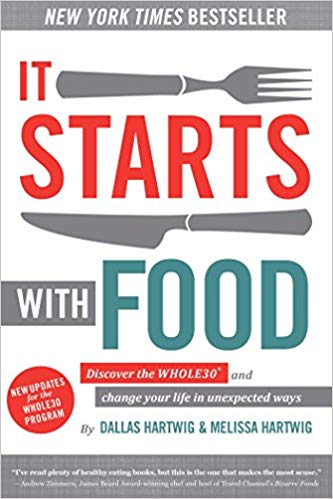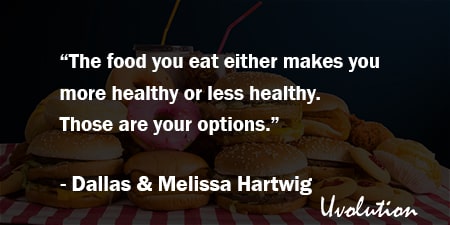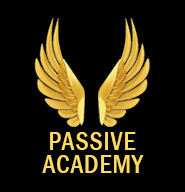It Starts with Food by Dallas and Melissa Hartwig
The Book in 1 Sentences
It Starts With Food: Discover the Whole30 and Change Your Life in Unexpected Ways
“We eat real food—fresh, natural food, like meat, vegetables, and fruit. We choose foods that are nutrient-dense, with lots of naturally occurring vitamins and minerals, over foods that have more calories but less nutrition.
And food quality is important—we are careful about where our meat, seafood, and eggs come from, and we buy organic, local produce as often as possible.
This is not a ‘diet’—we eat as much as we need to maintain strength, energy and a healthy body weight. We aim for well-balanced nutrition, so we eat both plants and animals. We get all the carbohydrates we need from vegetables and fruits, while healthy fats like avocado, coconut, and olive oil provide us with another excellent source of energy.
Eating like this allows us to maintain a healthy metabolism and keeps our immune system in balance. It’s good for body composition, energy levels, sleep quality, mood, attention span, and quality of life.
It helps eliminate sugar cravings and reestablishes a healthy relationship with food. It also works to minimize our risk for most lifestyle-related diseases and conditions, like diabetes, cardiovascular disease, stroke, and autoimmune conditions.” ~ Dallas Hartwig & Melissa Hartwig
6 BIG Ideas
It Starts with Food Book Summary
1. Food should make you healthy
“We have a theory about food that directly influences the rest of the book.
The food you eat either makes you more healthy or less healthy.
Those are your options.
There is no food neutral; there is no food Switzerland—every single thing you put in your mouth is either making you more healthy or less healthy.
It should be simple then, right? Just eat the foods that make you more healthy.
Well, it is and it isn’t.”
2. Experiment Whole30 Program
“We’re going to share our views on food. We’ll share our personal experiences. We’ll give you testimonials from others who have changed their lives just by changing the food on their plate.
And we’ll give you the science—the studies, experiments, and conclusions that form the basis for all of our recommendations.
And then we’ll say, ‘Don’t just take our word for it.’
We are going to teach you how to turn yourself into a scientific experiment of one, so you can figure out for yourself, once and for all, whether the foods you are eating are making you more healthy or less healthy.
And that’s worth more than any scientific findings you read about—because there hasn’t been a single scientific experiment that includes you as a subject.
Until now.
When you complete our Whole30 program, you’ll see for yourself the effects of more healthy and less healthy foods. By the time the program is over, you’ll know in no uncertain terms which foods are improving the quality of your life and which are detracting from your health.
In just thirty days, you will have gained that incredibly powerful knowledge. Why is this knowledge so valuable?
Because it will change your life.”
3. Myths about the Paleo diet
“Before we go any further, let’s debunk some myths about the Paleo diet. First, it’s not about recreating the existence of cavemen. No one wants you to go without electricity, hot showers, or your beloved iPhone.
And yes, cavemen didn’t always have a long life span, but that’s not because of their food choices—it was more likely the lack of antibiotics, the abundance of predators, and harsh living conditions.
Second, it’s not a carnivorous diet—the moderate amount of high-quality meat is balanced with tons of plant matter (vegetables and fruit).
Third, the fat you eat as part of a Paleo diet will not clog your arteries because fat all by itself is not the culprit in that scenario. (Really. More on that later.)
Finally, the diet is not carb-phobic; it’s 100 percent sustainable from day one, and it’s really not that radical—unless you consider eating nutrient-dense, unprocessed food radical. Which, in today’s microwave-dinner-fast-food-low-fat era, might very well be the case.”
“Remember that old adage ‘You are what you eat’? We like to take that one step further, borrowing a clever turn of phrase from author Michael Pollan: ‘You are what what you eat eats.’”
“Your hormonal troubles start with ‘overcarbsumption’: the chronic overconsumption of supernormally stimulating, nutrient-poor, carbohydrate-rich foods.”
“Eating whole, unprocessed foods with a rich complement of fat is *not* unhealthy. Overeating refined carbohydrates *is.*”
4. Good Food standards
“We choose foods by following four Good Food standards. We’re pretty picky about this: all the foods we recommend have to satisfy all four criteria. Not three, not most... all. We’ll explain them in more detail in the coming chapters, but here are the basics.
The food we eat should:
1. Promote a healthy psychological response.
2. Promote a healthy hormonal response.
3. Support a healthy gut.
4. Support immune function and minimize inflammation.”
Check the book Chapter #3: “What Is Food?” for more on that.
5. Grains
“The marketing from big cereal companies would have you think that cereal grains are highly nutritious—and that if you don’t eat them, you’ll miss out on all sorts of vitamins, minerals, and fiber that you can get only from grains.
That’s simply not true.
Grains are not (we repeat, not) nutrient-dense when compared with vegetables and fruit.”
“Another way that a diet high in grains leads to suboptimal nutrition is in terms of opportunity cost: If there are more whole grains on your plate, then there’s probably less of some other food—like vegetables—on your plate. And that lowers the overall micronutrient density in your diet too. In summary:
There is not a single health-promoting substance present in grains that you can’t also get from vegetables and fruit.”
6. Health and fitness is multifactorial
“Of course, while we believe your journey to optimal health starts with food, there are other factors that also play important roles.
Health and fitness is multifactorial, and while nutrition is always the foundation, we also believe that you cannot focus on just one aspect of health at the exclusion of others. Sleep, exercise habits, and stress also factor into your personal health equation.”
That was my QUICK summary of the great book It Starts with Food by Dallas and Melissa Hartwig. If you’re interested, get your copy. There is a HUGE amount of life-changing ideas in this book, and we’ve only touched on a tiny bit of it.
Buy The Book: It Starts with Food by Dallas & Melissa Hartwig

GET Blinkist 7 Days FREE Trial
3000+ Book Summaries
(Audio and Text)








